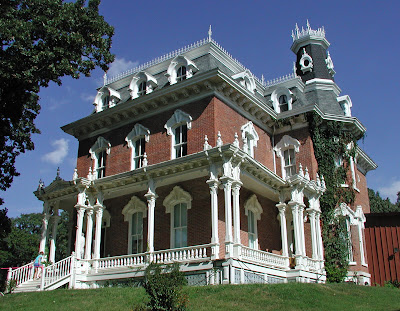Many 19th century building styles, including the Federal, Greek Revival, Gothic Revival and Italianate, were inspired by historic precedents and featured antique details such as lancet arches, brackets and classical architraves. Around the middle of the century, however, some Americans opted for a more “modern” style which emulated fashionable designs current in Paris. This modern style, called the Second Empire, proved to be especially popular in the Midwest and Northeast following the Civil War and many examples remain in small towns and large cities alike.
One outstanding example is the Early Mansion, a 1875 house built by D. Carr Early in Sac City, IA. A native of Freeburg, OH, Early pre-empted a quarter section of land near Sac City in 1857 and prospered due to investments in a local bank and railroad. He built a grand home in the fashionable Second Empire style and had its furnishings delivered via ox cart from Fort Dodge, IA, which was 60 miles distant across the open prairie.
What distinguishes the Second Empire? First and foremost is the mansard roof. This dual-pitched roof design, named after the 17th century French architect François Mansart (1598-1666), allowed more efficient use of attic space. The design proved so practical that many existing buildings with traditional roofs were remodeled with the mansard. High style examples of the Second Empire often feature towers, elaborate molded hoods over windows and brackets along the cornice. Despite being considered a “modern” style, its detailing (apart from the mansard roof) closely resembles the picturesque Italianate style popular since the 1840s.
Another fine Iowa example of the Second Empire style is the Harker House in Storm Lake, IA. This cottage was built by 1875 by J. M. Russell for $500 dollars. Although smaller than the Early Mansion, the Harker House features many of the same design elements. The Harker House has been preserved as a house museum with many of its original furnishings thanks to efforts of Russell’s granddaughter Nora Harker.
You might ask “What exactly does the name Second Empire mean?” The Second Empire refers to the regime of Napoleon III who ruled France between 1852 and 1870 (the First Empire was, of course, the regime of his uncle Napoleon Bonaparte). One major project of Napoleon III was the modernization of medieval Paris into a modern capital city capable of supporting its burgeoning population. Napoleon III tasked Baron Haussmann with renovating the old city and, over the following decades, virtually all of medieval Paris was demolished and replaced with the grand boulevards and buildings we recognize today. The design for many of the buildings built in Haussmann’s new Paris was based on Renaissance precedents and incorporated the Mansard roof. The Exposition Universelle in Paris in 1855 and the International Exhibition in London in 1867 popularized the new style and it was to become common in style books in the United States.
To visit the Harker House, check out their web page or visit their Facebook page.



0 Comments